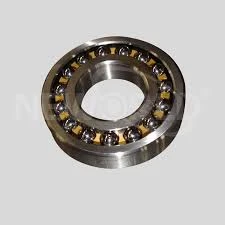
Nov . 11, 2024 13:16 Back to list
deep groove ball bearing specification
Deep Groove Ball Bearing Specifications
Deep groove ball bearings are among the most widely used types of rolling bearings, recognized for their versatility and ability to accommodate radial and axial loads in both directions. These bearings consist of an inner ring, an outer ring, a cage, and rolling elements (balls). Their design allows for a high level of performance in various applications, making them essential components in mechanical engineering and manufacturing. Understanding the specifications of deep groove ball bearings is crucial for selecting the right bearing for specific applications.
1. Basic Specifications
The primary specifications of deep groove ball bearings include
- Diameter Bearings are categorized by their bore diameter, which is the inner diameter of the inner ring. Common bore sizes range from a few millimeters to over 300 mm.
- Width The width of the bearing is the axial distance between the faces of the inner and outer rings. This dimension is equally critical, as it can influence the load-carrying capacity of the bearing.
- Outer Diameter This measurement is the external diameter of the outer ring. It is essential for determining the fit in the housing.
2. Load Ratings
Deep groove ball bearings have specified dynamic and static load ratings. Dynamic load rating refers to the maximum load a bearing can endure while in operation, while static load rating refers to the maximum load when the bearing is not rotating. These ratings are expressed in kilonewtons (kN) and vary with size and design. Choosing a bearing with appropriate load ratings is vital for ensuring a long service life under operational conditions.
deep groove ball bearing specification

Another crucial specification is the bearing's speed rating, which indicates the maximum operating speed of the bearing, usually stated in revolutions per minute (RPM). The speed rating may be influenced by several factors, including the type of lubricants used, the bearing's internal design, and the operating conditions. If the bearing operates above its rated speed, it can lead to overheating and premature failure.
4. Material and Design
Deep groove ball bearings are typically made from chrome steel (AISI 52100), stainless steel, or ceramic. The choice of material affects the bearing's load capacity, resistance to corrosion, and thermal properties. For instance, stainless steel bearings resist rust and are ideal for applications in humid environments.
Furthermore, the design of deep groove ball bearings may include options such as seals or shields that help retain lubricant and protect against contaminants. Sealed bearings are typically preferred in environments exposed to dust or moisture, while open bearings allow for more favorable cooling in applications that produce heat.
5. Precision and Tolerances
Precision ratings of deep groove ball bearings are classified according to standards set by institutions like the International Organization for Standardization (ISO) and the American National Standards Institute (ANSI). Tolerances can be standard or can be customized to suit specific applications. Higher precision bearings, often labeled as ABEC 1, 3, 5, 7, or 9, are designed for minimal internal clearances, leading to reduced noise and vibration.
6. Applications
Deep groove ball bearings are ubiquitous in various industries. They are found in automotive applications, machinery, electric motors, appliances, and many more. Their flexibility in handling both axial and radial loads makes them suitable for applications with oscillating or changing directions of load.
Conclusion
Deep groove ball bearings are critical components with specifications that drive their performance in numerous applications. When selecting a bearing, it is important to consider factors such as load ratings, speed ratings, material, and specific design features to ensure optimal performance. By understanding these specifications, engineers and manufacturers can make informed decisions, resulting in enhanced efficiency and reliability in their machinery and equipment. As technology advances, the evolution of deep groove ball bearings continues, offering improved performance and durability for a wide range of applications.
Latest news
-
Premium Deep Groove Ball Bearings | High Speed & Reliability
NewsAug.29,2025
-
Durable Scaffolding Clamps - Secure & Reliable Tube Connectors
NewsAug.28,2025
-
Common Failures in Thrust Ball Bearings and Solutions
NewsAug.22,2025
-
How Tapered Roller Bearings Can Take Shock Loads
NewsAug.22,2025
-
Angular Bearings in High-Precision Spindles
NewsAug.22,2025
-
The Impact of Misalignment on Cylindrical Roller Bearing Performance
NewsAug.22,2025
